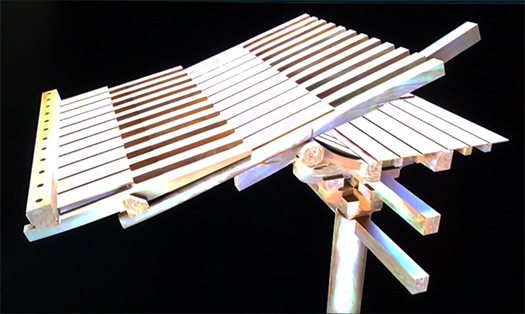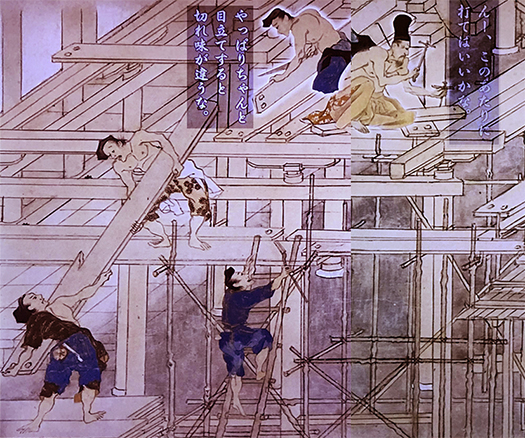

日本木造建築の進化プロセスにとっては神社仏閣は格別の存在。
国家プロジェクトとして取り組まれる大型建築は鎮護国家建築であり、
政争の結果、しばしば消失することのある政治的象徴建築や城郭と比べて
比較的長期間にわたって建ち続けることが多い。
法隆寺がその最たるものと言われるが建築では四天王寺が時代を画する存在。
この日本最初の仏教寺院は聖徳太子に起源が求められ、
事実、境内には日本の大工仕事の守護神として聖徳太子が祀られている。
それまでの日本の建築にはなかった装飾性の高いデザイン、むくり屋根などが
特徴的な端部として、日本建築に受容されていった。
上の写真は竹中大工道具館ムービー展示で示されていたその箇所。
朝鮮から四天王寺建設のために来日した木造技術者が日本最古の工務店、
金剛組として現代にまで存続してきているけれど、
こういった端部での仕上げ加工技術の重厚さに驚かされる。
結局は肉体化された職人技術としてしか継承存続できない。
その必然として小人数での相伝的な組織形態を取っていくことになる。
この技術伝承スタイルは日本人にはある意味、似合っているのかも知れない。
この菅原道真の魂魄を鎮魂する天神社でもその技術の粋が懲らされた。
マザーの三内丸山、縄文時代からの木造伝統が強く存在する技術風土に
大陸・半島から宗教建築の技術が加わっていったのでしょう。
中国・朝鮮・日本で木造技術の発展の仕方は大きく相違する。
そもそも今日社会まで存命し続けてきたのは日本だけ。
現在中国国内に残る木造建築は日本の技術支援がなければ存続し得ない。
中国の場合、政治体制が常に「独裁」であり、ときの皇帝型権力の恣意で
宗教弾圧が行われ、宗教施設にまで迫害が及んでしまう。
直近では文化大革命によって宗教は極限的に痛めつけられた。
朝鮮社会でも事情は類似していて確固たる木造技術蓄積に乏しい。
ひとり日本だけもともとの縄文的木組み技術があってそれに刺激として
大陸・半島からの技術が加わっていったのでしょうが、
既存のものと渡来技術が融合していったのが日本木造なのでしょう。
だから東アジア世界の中で日本は独自の技術体系を構築し得た。
ただ先述の技術伝承スタイルが前提としていた日本人的精神風土が
現代世界の普遍的な西欧的個人主義とのせめぎ合いの中で
複雑精緻なディテール技術を今後とも存続させられるのかどうか、
あやうさも持っているように思われてならない。
日本社会は外からの文化刺激を柔軟に血肉化することが巧みで
その「融合力」といえる自然な復元機能が働いてくれる気もする。
世界に開かれたガラパゴス的な咀嚼パワー。
なんとも不思議な日本のありようをはるかな時間経過の中で
絵巻物文物から教えられているように思います。
English version⬇
[Ingenuity of craftsmanship and inheritance of technology / Special edition of Japanese good house ㊲-5]
Shrines and temples are exceptional for the evolutionary process of Japanese wooden architecture.
The large-scale architecture that is being tackled as a national project is such a guardian national architecture.
Compared to political symbolic architecture and castles that often disappear as a result of political disputes
It often continues to be built for a relatively long period of time.
Horyu-ji is said to be the best, but in architecture, Shitenno-ji is the one that sets the era.
The origin of this first Buddhist temple in Japan is sought from Prince Shotoku,
In fact, Prince Shotoku is enshrined in the precincts as the guardian deity of Japanese carpentry.
Highly decorative design, rolled roof, etc. that were not found in Japanese architecture until then
As a characteristic end, it was accepted by Japanese architecture.
The photo above is the part shown in the Takenaka Carpentry Tools Museum movie exhibition.
A wooden engineer who came to Japan from Korea to build Shitennoji is Japan’s oldest construction shop.
Although it has survived to the present day as Kongo Gumi,
I am amazed at the profoundness of the finishing technology at these edges.
In the end, it can only be inherited as a physical craftsmanship.
Inevitably, we will take a traditional organizational form with a small number of people.
However, this technique transfer style may suit Japanese people in a sense.
The essence of the technique was also disciplined at the Tenjinsha Shrine, which requiescats the soul of Sugawara no Michizane.
Originally Sannai Maruyama, in a technical climate where the wooden tradition from the Jomon period strongly exists
The technology of religious architecture may have been added from the continent and peninsula.
The way of developing wooden technology is very different between China, Korea and Japan.
In the first place, Japan is the only country that has survived to society today.
Today, the wooden buildings that remain in China cannot survive without Japanese technical backup.
In the case of China, the political system is always “dictatorship”, and at the time of emperor-type power.
Religious repression is carried out, and persecution extends to religious facilities.
Most recently, the Cultural Revolution has severely damaged religion.
The situation is similar in Korean society, and there is little solid accumulation of wooden technology.
Only in Japan alone, there was the original Jomon woodworking technique, and as a stimulus to it
Technology from the continent and peninsula may have been added,
It is probably Japanese wooden construction that the existing ones and the traditional technology were fused.
Therefore, Japan was able to build its own technical system in the East Asian world.
However, the Japanese spiritual climate that was premised on the above-mentioned technical tradition style
In a conflict with the universal Western individualism of the modern world
Whether complex and elaborate things such as braids can be kept alive in the future
Don’t seem to have a suspicion.
Japanese society is skillful in flexibly fleshing out cultural stimuli from the outside.
I feel that the natural restoration function, which can be said to be the “fusion power”, works.
Galapagos-like chewing power open to the world.
What a mysterious state of Japan in the distant passage of time
I think it is taught from picture scrolls and antiques.
Posted on 7月 28th, 2021 by 三木 奎吾
Filed under: 住宅マーケティング, 日本社会・文化研究







コメントを投稿
「※誹謗中傷や、悪意のある書き込み、営利目的などのコメントを防ぐために、投稿された全てのコメントは一時的に保留されますのでご了承ください。」
You must be logged in to post a comment.